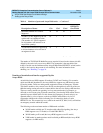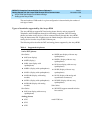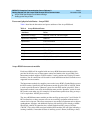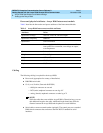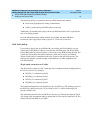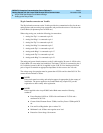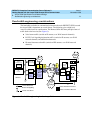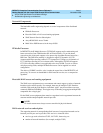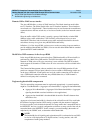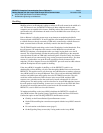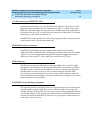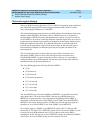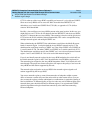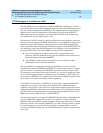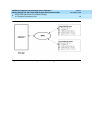
DEFINITY Enterprise Communication Server Release 9
Getting Started with the Avaya R300 Remote Office Communicator
Issue 1
November 2000
Avaya R300 Specifications and Network Design
22Bandwidth engineering considerations
2
Network Components
The bandwidth traffic engineering depends on several components of the distributed
network:
■ IP Media Processors
■ Host-side WAN or LAN access/routing equipment
■ WAN Network Services Subscription
■ Avaya R300 WAN Access Trunks
■ Multi-Voice DSP Resources in the Avaya R300
IP Media Processor
In DEFINITY, the IP Media Processor (TN2302AP) supports audio conferencing and
bearer conversion (from TDM based traffic to IP based traffic). To provide bearer
conversion, this circuit pack supports voice processing algorithms that are housed in a
DSP farm. This DSP farm currently is designed to support 32 channels of G.729
(compressed 8 Kbps encoding) and/or G.723 (compressed 5.3 Kbps) or 64 channels of
G.711 (64 Kbps encoding) for voice bearer traffic. Although the TN2302AP supports
G.723, this encoding scheme is not applicable to the Avaya R300. To scale to various
switch processing needs, multiple IP Media Processors can be supplied in a switch
configuration.
The choice of CODECs used for voice is under the supervision of the DEFINITY call
processing. To conserve on bandwidth for WAN network services, use a compression
algorithm.
Host-side WAN access and routing equipment
The WAN access equipment (access concentrator and router) support a variety of network
interfaces and a certain capacity. For example, there may be multiple T1/E1 interfaces
available. With each physical interface, individual “pipes” may be used (these are most
commonly DS0-based (64Kbps). These pipes may use bonding to aggregate multiple DS0
components into a larger pipe.
For the WAN access equipment, there must be a negotiated service agreement between the
customer and the enterprise/public network provider.
NOTE:
IP- based streams must always traverse some kind of physical channel.
WAN network services subscription
The supporting network is arranged/subscribed in terms of a negotiated network service
between you and your service provider. This service is a function of the:
■ service type such as fractional T1/E1, full T1/E1, frame relay, etc.
■ number of network interfaces (for example, multiple T1/E1)




